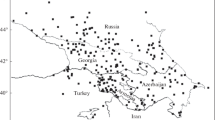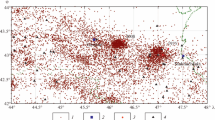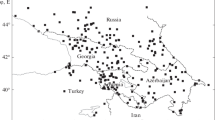Abstract
It is necessary to have reliable data on the distributions of earthquake hypocenters in the study area to solve many geological and geophysical problems, in particular, the forecast of strong earthquakes, seismic zoning and earthquake-proof construction. In turn, the completeness of the data on the distribution of earthquake hypocenters and the accuracy of their determination largely depends on the effectiveness of the observing system. The efficiency of the modern Ukrainian network of seismological observations that consists of 28 stations is estimated in this article. By the effectiveness of the seismological observation network we mean the ability of the network to record events with minimal magnitudes at certain epicentral distances and allowing us to determine its main parameters (time in the focus and coordinates of hypocenters) with minimal errors depending on the position of the earthquake hypocenter. Calculation of the minimum magnitude of earthquakes for the Ukrainian seismological network shows if each seismic station increase of susceptibility to 50,000 units then the seismological the network confidently registers earthquakes with a magnitude of 3 or more throughout the Ukraine. The errors in the determination of the coordinates of epicenters of earthquakes in latitude (δφ) (km) and in longitude (δλ) (km) do not exceed 1.0 km in the center of the network and 5.0 km on the periphery of the network. The values of errors in determining the depths of the earthquake (H) (km) centers in the center of the network does not exceed 5.0 km but on the whole territory of Ukraine does not exceed 20 km. The optimal configuration of the network of Ukrainian seismic stations based on the C-criterion of optimality, introduced earlier to the theory design of optimal experiments by one of the authors of the article, is proposed.











Similar content being viewed by others
References
Antonova, L. V., Aranovich, Z. I., & Kondorskaya, N. V. (1974). Magnitude and station efficiency in connection with the problem of optimizing seismic observations. Magnitude and energy classification of earthquakes (Vol. 2, pp. 195–202). Moscow: IHE AS of the USSR.
Aranovich, Z. I., Akhalbedashvirli, A. M., Gotsadze, O. D., & Dekanosidze, T. A. (1977). Methodology for calculating the efficiency of a network of regional seismic stations in the Caucasus example. Questions from the automation and automation of seismic observations (pp. 27–57). Tbilisi: Metsniereba.
Bartal, Y., Somer, Z., Leonard, G., Steinberg, D. M., & Horin, Y. B. (2000). Optimal seismic networks in Israel in the context of the comprehensive test ban treaty. Bulletin of the Seismological Society of America, 90(1), 151–165.
Burmin, V. Y. (1976). The problems of design an experiments and the conditionality of systems of linear algebraic equations. Izvestiya Academy of Sciences of the USSR. Technical Cybernetika, 2, 195–200. (in Russian).
Burmin, V. Y. (1986). The optimal location of seismic stations during the registration of nearby earthquakes. Izvestiya Academy of Sciences of the USSR. Physics of the Earth, 5, 34–42.
Burmin, V. Y. (2013). Design of optimal seismic and acoustic networks. Non-statistical approach. Saarbrücken: Germany Lap Lambert Academic Publishing.
Burmin, V. Y. (2019a). Assessment of the caucasus seismological network effectiveness. Seismic Instruments, 55(2), 129–135.
Burmin, V. Y. (2019b). Optimal geometry for the seismological observation network in the caucasus region. Seismic Instruments, 55(3), 353–362.
Burmin, V. Y., & Akhmetev, V. M. (1994). Errors in the determination of the parameters of hypocenters of nearby earthquakes, the effectiveness of the system of seismological observations. Volcanology and Seismology, 2, 109–128.
Burmin, V. Y., Ly, N. T., Kondorskaya, N. V., & Akhmetyev, V. M. (1992). Analysis of the geometry of the modern network of seismic stations and determination of the position of additional stations in the territory of North Vietnam. Izvestiya RAS Physics of the Earth, 6, 123–128.
Burmin, V. Y., & Van Phong, N. (2001). Planning an optimal regional network of seismological observations for Southeast Asia. Volcanology and Seismology, 1, 68–75.
Burmin, V. Y., Thi, L. N., & Phuong, C. V. (2009). Evaluation of the effectiveness of modern and planning an optimal network of seismic stations in Vietnam. Seismic Instruments, 45(1), 27–35.
Burmin, V. Y., Thi, L. N., Fung, T. T. H., & Le, K. K. (2017). Evaluation of the effectiveness of a new network of seismic observations in the territory of Vietnam. Seismic Instruments, 533(3), 74–86.
Burmin, V. Y., Van Fong, N., & Avetisyan, A. M. (2000). Planning an optimal regional network of seismological observations on the example of Armenia. Volcanology and seismology, 6, 66–79.
Burmin, V. Y., & Van Phong, N. (2001). Planning an optimal regional network of seismological observations for Southeast Asia. Volcanology and Seismology, 1, 68–75.
Iosif, T., & Iosif, S. (1974). Optimization of seismic stations distribution in Romania. Studii si cercetari de geofisica, 12, 51.
Iosif, T., & Skoko, D. (1974). Optimization of new station position for Vrancea and Cimpulung seismic region №Romania.). Stud tehn si econ Inst Geol, 10(2), 147–172.
Kagan, Y. Y. (1999). Universality of the seismic moment-frequency relation. Pure and Applied Geophysics, 155, 537–573.
Kendzer, A., Verbitsky, T., Verbitsky, S., & Verbitsky, U. (1998). Digital seismograph for regional observations and the results of its tests. Geodynamics, 1, 120–126.
Kendzera, O. V., Pustovitenko, B. G., Kutas, V. V., Kulchitsbky, V. E., Verbitsky, S. T., Pronishin, R. S., Safronov, O. M., Korolov, V. O., Kalitova, I. A., Pasinkov, G. D., Stasyuk, A. F. (2008). Seismicity of Ukraine. World center of data from geoinformatics and sustainable development, Ukraine, https://wdc.org.ua/uk/node/192.
Kijko, A. (1977a). An algorithm for the optimum distribution of a regional seismic network—I. Pure and Applied Geophysics, 115(4), 999–1009.
Kijko, A. (1977b). An algorithm for the optimum distribution of a regional seismic network—II. An analysis of the accuracy of location of local earthquakes depending on the number of seismic stations. Pure and Applied Geophysics, 115(4), 1011–1021.
Kijko, A. (1981). Methods of the optimal planning of regional seismic networks. In Vychislitel’nye metody v geofizike (Computational Methods in Geophysics) (pp. 82–84). Moscow: Nauka.
Kondorskaya, N. V., Aranovich, Z. I., Solovyova, O. N., & Shebalin, N. V. (1981). Instructions on the procedure for the production and processing of observations at seismic stations ESSN USSR. Moscow: Nauka.
Kushnir, A. N., Kulik, S. N., & Burakhovich, T. K. (2013). Seismicity of the platform regions of Ukraine in the areas of electrical conductivity anomalies. Physics of Earth, 3, 95–105.
Lee, W. H. K., & Steward, S. W. (1981). Principles and applications of microearthquake networks. New York: Academic Press.
Omelchenko O.K., Beloborodov V.N. 1968. Optimal planning of the regional seismological network. Report No.688, Computer Center of Sibirian Department of Academy Science USSR. Novosibirsk.
Onofrash, N. I., & Roman, A. A. (1979). Kolichestvennaya interpretatsiya makroseismicheskogo polya (Quantitative Interpretation of Macroseismic Field). Chishinau: Shtiintsa.
Pigulevskyy, P. I., Scherbina, S. V., Gurova, I. Y., & Svistun, V. K. (2013). Krivoy Rog earthquake on June 23, 2013. Geodynamic, 2(15), 283–285.
Rabinowitz, N., & Steinberg, D. M. (1990). Optimal configuration of a seismographic network: A statistical approach. Bulletin of the Seismological Society of America, 80(1), 187–196.
Sato, Y. (1965). Optimum distribution of seismic observation points. Zisin (Journal of the Seismological Society of Japan), 18(1), 9–14.
Sato, Y., & Skoko, D. (1966). Optimum distribution of seismic observation points. II. Zisin (Journal of the Seismological Society of Japan)., 43(3), 451–458.
Savarensky, E. F., Safronov, V. V., Peshkov, A. B., et al. (1979). Optimal placement of seismic stations from the position of minimizing the error in determining the epicenter. Physics of the Earth, 8, 64–71.
Shumlianska, L. O. (2008). Mantle blocks and zones of increased permeability in the Ukrainian Shield. Geophysics Journal, 2, 135–144.
Shumlianska, L. O., & Aleksandrov, A. L. (2016). The earthquake of February 3, 2015, near Sumy, Ukraine: Source parameters and focal mechanism. Seismic Instruments, 4(52), 350–359.
Steinberg, D. M., Rabinowitz, N., Shimshoni, Y., & Mizrachi, D. (1995). Configuring a seismographic network for optimal monitoring of fault lines and multiple sources. Bulletin of the Seismological Society of America, 85(6), 1847–1857.
Steinberg, D. M., & Rabinowitz, N. (2003). Optimal seismic monitoring for event location with application to on site inspection of the comprehensive nuclear test ban treaty. Metrika, 58(1), 31–57.
Trifu, C.-I. (1983). Optimal development of a regional seismic network. Exemplification for Romania. Revue Roumaine de Physique, 28(1), 81–90.
Tripolskyy, A. A., Kendzera, A. V., Farfulyak, L. V., & Mychak, S. V. (2009). Analysis of tectonic and geological and geophysical conditions within the platform part of Ukraine in order to locate seismic stations. Geophysics Journal, 31(5), 115–127.
Tripolskyy, A. A., Farfulyak, L. V., & Mychak, S. V. (2012a). Features of the potentially seismogenic zone of the Ingulsky and Srednepridneprovsky megablocks of the Ukrainian shield. Geophysics Journal, 2(35), 168–178.
Tripolskyy, A. A., Kalyuzhnaya, L. T., & Tripolskaya, E. A. (2012b). Prediction of possible seismogenic zones in the Dnieper-Donets paleorift. Geophysics Journal, 1(34), 95–104.
Verbitsky, S. T., Stasyuk, A. F., Chuba, M. V., Pronishin, R. S., Verbitsky, J. T., & VKeleman, I. (2012). Seismicity of the carpathians in 2012 (pp. 22–29). Sevastopol: Seismological Bulletin of the Institute of Geophysics NAS Ukraine.
Vvedenskaya, N. A. (1955). On accuracy in determination of source position by cross method. Trudy Geofiana, 157(3), 127–136.
Uhrhammer, R. A. (1980). Analysis of small seismographic station networks. Bulletin of the Seismological Society of America, 70(4), 1369–1379.
Uhrhammer, R. A. (1982). The optimal estimation of earthquake parameters. Physics of the Earth and Planetary Interiors, 30, 105–118.
Author information
Authors and Affiliations
Corresponding author
Additional information
Publisher's Note
Springer Nature remains neutral with regard to jurisdictional claims in published maps and institutional affiliations.
Electronic Supplementary Material
Below is the link to the electronic supplementary material.
Rights and permissions
About this article
Cite this article
Burmin, V.Y., Shumlianska, L.A. Design of the Optimal Seismological Network in Ukraine. Pure Appl. Geophys. 177, 3651–3665 (2020). https://doi.org/10.1007/s00024-020-02453-9
Received:
Revised:
Accepted:
Published:
Issue Date:
DOI: https://doi.org/10.1007/s00024-020-02453-9




